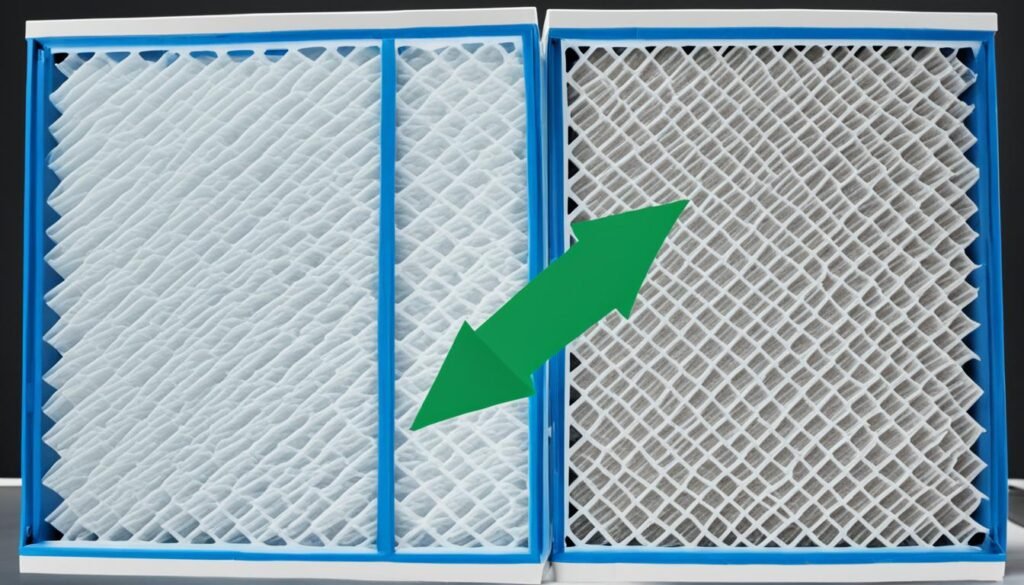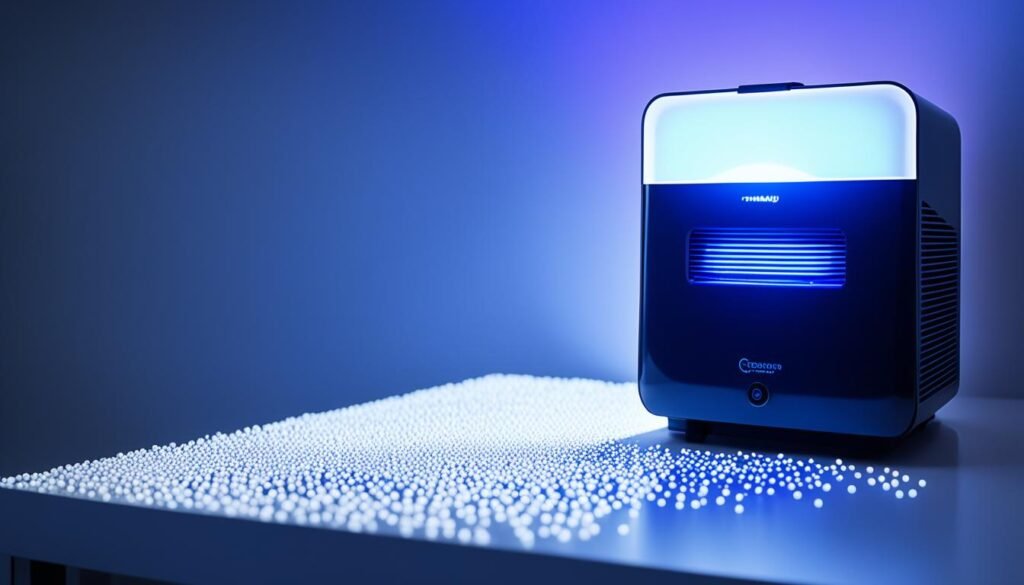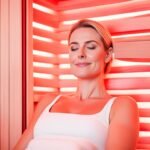I’ve been looking into air purifiers and how important they are for our air inside homes. Did you know our home air can be up to five times dirtier than the air outside? That’s why picking the right air cleaner is key.
I’ve found two main types: UV and ozone air purifiers. Both say they make our air cleaner, but which one is best? Let’s explore air purifiers and see which one wins.
Key Takeaways
- Indoor air can be 2-5 times more contaminated than outdoor air
- UV lights effectively kill most viruses, bacteria, and mold
- Ozone generators can produce harmful levels of ozone
- UV purifiers are safer and more effective for home use
- Combining UV lights with HVAC systems can greatly improve air quality
- California has banned ionic purifiers due to ozone production
- UV lights can deactivate airborne microorganisms in under 10 seconds
Introduction to Air Purification Technologies
I’ve looked into air purification technologies and found them really interesting. They help fight indoor air pollution. Did you know indoor air can be way more polluted than outside air? That’s why it’s key to know about these technologies to pick the right air purifier.
In my research, I saw several important technologies for cleaning the air and removing allergens:
- HEPA filters
- Activated carbon filters
- UV disinfection
- Ozone generators
- PECO technology
Each technology has its good points and downsides. HEPA filters are great at catching particles. Activated carbon helps with smells. But, UV and ozone can kill germs but you have to be careful.

The market for air purifiers is growing fast, with a 32.4% increase expected by 2024. This growth is making air purification tech better, with more patents filed from 2013-2016.
When picking an air purifier, think about what you really need. Do you want to get rid of allergens, bad smells, or germs? Knowing about these technologies will help you choose the best one for cleaner air at home.
| Technology | Best For | Limitations |
|---|---|---|
| HEPA | Particle removal | No odor control |
| Activated Carbon | Odor control | Limited particle removal |
| UV | Germ elimination | No particle or odor removal |
| Ozone | Odor elimination | Health concerns |
| PECO | All-around purification | Higher cost |
Understanding UV Air Purifiers
UV air purifiers are becoming popular for cleaning indoor air. I looked into how they work and their good and bad points. This info can help you decide if they’re good for your home.
How UV Light Disinfection Works
UV air purifiers use UV-C light, which has a special wavelength. This light changes the DNA of germs, making them kill themselves. They use mercury lamps that give off UV-C light at 254 nm for this job.

Benefits of UV Air Purifiers
UV air purifiers have many benefits:
- They kill bacteria, mold, and some viruses
- They can cut down on bad smells
- They may help with allergies
- They are safe to use in places where people live
- They are often used in hospitals
Limitations of UV Air Purifiers
But, UV air purifiers also have some downsides:
- They don’t work well against dust and pet hair
- They don’t remove harmful chemicals in the air
- You might need to add HEPA filters for more cleaning
- You have to replace the UV bulbs often
- Some models might make ozone, which is bad
When choosing between a UV and an ozone air purifier, think about these points. UV tech is great for killing germs, but it might not fix all air quality issues by itself.
The Science Behind Ozone Air Purifiers
Ozone generators make ozone molecules to clean indoor air. They break down pollutants. I looked into how they work and their effect on air quality.
Ozone (O3) is a gas that reacts quickly with other substances. It can clean the air by getting rid of pollutants. But, the real results are not always as good as expected.
Studies show ozone generators don’t always meet our hopes. Consumer Reports found many didn’t clean the air well. They also released too much ozone, which is bad for people.
The EPA now watches ozone levels closely because they’re harmful. Being around ozone can make you feel bad. It can cause:
- Chest pain
- Coughing
- Shortness of breath
- Throat irritation
Ozone can weaken our immune system and make breathing hard, especially when we exercise. It’s a big problem for people with asthma or allergies.
Ozone isn’t great at cleaning the air. It might take a long time to see any change. Sometimes, it can turn pollutants into something even worse. It doesn’t work well against dust, pet dander, or other common allergens.
“Ozone generators should not be used in occupied spaces. They create high concentrations of ozone, which can be harmful to health.”
After learning all this, I think we should be careful with ozone-based air purifiers. They might not be the best choice for making indoor air cleaner.
UV vs Ozone Air Purifier: A Comprehensive Comparison
UV and ozone air purifiers are often compared. I looked into both to help you pick the best for your home.
Effectiveness in Germ Elimination
UV air purifiers use UV-C light to kill germs. They work well with HEPA filters, catching 99.97% of tiny particles. Ozone generators claim to purify air but aren’t very effective and can be dangerous.
Safety Concerns
UV purifiers are safer for your home. Ozone generators can cause breathing problems. UV light must be installed right to avoid eye and skin harm.
Energy Efficiency
UV purifiers use less power and don’t make harmful gases. Ozone generators use more energy and can damage your stuff.
Maintenance Requirements
UV purifiers need new bulbs every 1-2 years. Ozone generators need more upkeep because they can break easily. HEPA filters, used with UV, should be changed every 6-12 months for best air cleaning.
| Feature | UV Air Purifier | Ozone Generator |
|---|---|---|
| Germ Elimination | Highly effective | Limited effectiveness |
| Safety | Generally safe with proper installation | Potential health risks |
| Energy Efficiency | More efficient | Less efficient |
| Maintenance | Periodic bulb replacement | Frequent maintenance required |
Health Implications of UV and Ozone Air Purifiers
I looked into the health effects of UV and ozone air purifiers. UV air purifiers are safe when set up right. They don’t make harmful stuff and can be used in places where people live. This makes them a good choice for getting rid of allergens.
Ozone air purifiers, however, are a big worry. The California Air Resources Board found some ozone makers send out more than 5,000 mg of ozone an hour. This is way over what’s safe. It can make indoor air much more polluted than outside air.
Being around too much ozone can cause:
- Coughing and chest tightness
- Shortness of breath
- Inflammation of the respiratory system
- Permanent lung damage
- Increased mortality risk, especially for the elderly and those with respiratory conditions
The EPA and WHO say ozone is a pollutant. They don’t want people to use it to clean the air. In 2007, CARB made rules to limit ozone from air cleaners. This led over 300 companies to make devices that don’t make ozone or make very little.
For safe and good air cleaning, I suggest looking into HEPA filters. They catch 99.97% of tiny particles, like allergens. This is a better choice than ozone generators.
Environmental Impact of UV and Ozone Technologies
I’ve looked into air purifiers and their effects on the air we breathe. UV and ozone technologies have different impacts on our environment. Let’s see how they change our surroundings.
Ozone Emissions and Air Quality
Ozone generators are sold as air cleaners but can harm the air. They add ozone, a pollutant, to the air. The Environmental Protection Agency (EPA) says not to buy air purifiers that make ozone.
There’s no proof that ozone cleans the air or kills germs. But, it can cause health problems:
- Decreased lung function
- Aggravated asthma
- Lung tissue inflammation
UV Light and Energy Consumption
UV air purifiers are better for the environment. They don’t release harmful gases and use little energy. UV light is a safe way to kill germs indoors.
A study showed UV light can kill 99.9% of coronaviruses in 25 minutes. This method works by damaging the DNA of germs. It’s effective against viruses, bacteria, and fungi.
“UV disinfection devices create a safe disinfection zone in the upper area of a room, effectively killing germs without harming occupants.”
When picking air purifiers, think about both air quality and the planet. UV tech is better for the environment and safe for long-term use than ozone generators.
Cost Analysis: UV vs Ozone Air Purifiers
I’ve looked at UV and ozone air purifiers to help you choose the best for your home. The initial costs can be tricky to understand. UV air purifiers might cost more at first but save money over time.
Let’s look at the costs of both purifiers:
| Cost Factor | UV Air Purifiers | Ozone Air Purifiers |
|---|---|---|
| Initial Purchase | Higher | Lower |
| Maintenance | Low | Moderate |
| Energy Efficiency | High | Moderate |
| Replacement Parts | UV Bulbs (1-2 years) | Ozone Plates (6-12 months) |
| Integration with HVAC Systems | Seamless | Limited |
UV purifiers work well with your HVAC system, which can save you money on energy bills. This can add up to big savings over time.
Ozone purifiers might look cheaper at first, but they can cost more later. You also have to think about health risks and damage to your stuff. UV purifiers are safer and save you money in the long run for most homes.
“Investing in a UV air purifier may cost more upfront, but the long-term benefits to your health and wallet are undeniable.”
The real cost of an air purifier is more than just the price. Think about the clean air, less upkeep, and saving on energy bills when you decide.
Ideal Applications for UV Air Purifiers
UV air purifiers are great for making indoor air cleaner. They work well in homes, offices, hospitals, and schools. This is because they kill germs really well.
UV air purifiers can run all the time in places people are. This means they keep the air clean 24/7. It’s like having a guard against germs always ready.
UV air purifiers are super at fighting mold and bacteria in HVAC systems. Putting UV lights in these systems makes the air in your whole place much cleaner.
| Application | Benefits of UV Air Purifiers |
|---|---|
| Healthcare Facilities | Reduces risk of hospital-acquired infections |
| Schools | Minimizes spread of common illnesses |
| Offices | Improves employee health and productivity |
| Homes | Alleviates allergy and asthma symptoms |
UV air purifiers work best with HEPA filters. HEPA catches particles, and UV kills germs. Together, they make the air super clean.
“UV lights installed in HVAC systems can drastically improve indoor air quality by deactivating airborne microorganisms in under 10 seconds upon exposure.”
Use UV air purifiers in damp places to stop mold. They work best if they’re set up right and kept clean. This makes them really effective at killing germs.
When to Consider Ozone Air Purifiers (If Ever)
I’ve looked into ozone generators and air cleaning tech a lot. They’re said to clean the air well, but I don’t suggest them for daily use. The downsides often beat the upsides.
Limited Use Cases
Ozone air purifiers might be good in certain situations. For example, they can get rid of smells after a fire. But these situations are not common. Usually, safer choices like HEPA filters or carbon-based purifiers are better. They don’t make harmful gases.
Safety Precautions
If you need an ozone generator, be very careful. Don’t use it where people will be. Studies link high ozone levels to more deaths in cities. Make sure the area is well-ventilated before letting people in. Some air purifiers can make indoor ozone levels six times higher than outside. That’s why I prefer ozone-free options for cleaner, safer air.
FAQ
What is the difference between UV and ozone air purifiers?
UV air purifiers kill germs with ultraviolet light. Ozone generators make ozone gas to break down pollutants. UV is safer and better at killing germs. Ozone can be bad for people.
How does UV light disinfection work?
UV light hurts the DNA of germs, stopping them from spreading. This method works on viruses, bacteria, and fungi.
Are UV air purifiers safe for use in occupied spaces?
Yes, UV air purifiers are safe when used right. They don’t make harmful gases and can be used where people are.
What are the potential health risks of ozone air purifiers?
Ozone air purifiers can harm your health. They can make breathing hard, hurt your lungs, and cause chest pain. The EPA and WHO say ozone is a pollutant.
Which air purifier technology is more energy-efficient?
UV air purifiers use less energy and need less upkeep than ozone generators. Ozone generators can also harm rubber things in your home.
What are the ideal applications for UV air purifiers?
UV air purifiers work well in many places like homes, offices, and schools. They’re great where germs need to be stopped. They can run all the time in places people are.
Are there any safe applications for ozone air purifiers?
Ozone air purifiers can be used in empty rooms for getting rid of smells or deep cleaning after fires. But, you must be very careful. Always look for safer options first.







